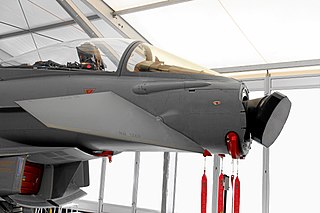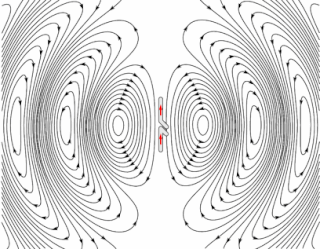
An active electronically scanned array (AESA) is a type of phased array antenna, which is a computer-controlled array antenna in which the beam of radio waves can be electronically steered to point in different directions without moving the antenna. In the AESA, each antenna element is connected to a small solid-state transmit/receive module (TRM) under the control of a computer, which performs the functions of a transmitter and/or receiver for the antenna. This contrasts with a passive electronically scanned array (PESA), in which all the antenna elements are connected to a single transmitter and/or receiver through phase shifters under the control of the computer. AESA's main use is in radar, and these are known as active phased array radar (APAR).

Imaging radar is an application of radar which is used to create two-dimensional images, typically of landscapes. Imaging radar provides its light to illuminate an area on the ground and take a picture at radio wavelengths. It uses an antenna and digital computer storage to record its images. In a radar image, one can see only the energy that was reflected back towards the radar antenna. The radar moves along a flight path and the area illuminated by the radar, or footprint, is moved along the surface in a swath, building the image as it does so.

An airport surveillance radar (ASR) is a radar system used at airports to detect and display the presence and position of aircraft in the terminal area, the airspace around airports. It is the main air traffic control system for the airspace around airports. At large airports it typically controls traffic within a radius of 60 miles (96 km) of the airport below an elevation of 25,000 feet. The sophisticated systems at large airports consist of two different radar systems, the primary and secondary surveillance radar. The primary radar typically consists of a large rotating parabolic antenna dish that sweeps a vertical fan-shaped beam of microwaves around the airspace surrounding the airport. It detects the position and range of aircraft by microwaves reflected back to the antenna from the aircraft's surface. In the US the primary radar operates at a frequency of 2.7 - 2.9 GHz in the S band with a peak radiated power of 25 kW and an average power of 2.1 kW. The secondary surveillance radar consists of a second rotating antenna, often mounted on the primary antenna, which interrogates the transponders of aircraft, which transmits a radio signal back containing the aircraft's identification, barometric altitude, and an emergency status code, which is displayed on the radar screen next to the return from the primary radar. It operates at a frequency of 1.03 - 1.09 GHz in the L band with peak power of 160 - 1500 W.

The Type 364 radar was developed by the Yangzhou Marine Electronic Instruments Research Institute (扬州船用电子仪器研究所) / No. 723 Research Institute. It is typically enclosed in a dome on new PLA-N's frigates and destroyers.

The Type 360 is an air/surface search radar manufactured by Yangzhou Marine Electronic Instruments Research Institute (扬州船用电子仪器研究所)/ No. 723 Institute and is reportedly based on Selenia RAN-10S / SPS – 774. It is deployed on a number of new PLAN vessels, such as the Ma'anshan class frigate.

Type 517 radar is believed to be an A-band/VHF air search radar widely deployed on PLA-N surface vessels with 4 antennas in two crossed-brace supported pairs, one above the other, mounted in pairs on each side of a single tubular support carried on the turning gear.
The JY-9 Radar is a mobile S-band low altitude search radar intended for use in air defense, gap filling, airport surveillance and coastal defense. It is designed for effective detection of targets at low altitude in both ECM and natural clutter environments. The general designer of JY-9 is the head of 38th Research Institute, academician of Chinese Academy of Sciences Mr. Wu Manqing, who is also the general designer of JY-8 and the general designer of the radar systems for KJ-2000 and KJ-200.
CLC-1 short-range surveillance radar is a ground-based mobile tracking radar used by the People's Liberation Army of China.
YLC-4 is a Chinese UHF solid-state, fully coherent 2D long range surveillance radar, which is mainly used for long range surveillance. The radar has the ability to synthesize data from up to four other radars with a large data capacity, and to communicate and display the data and state of the system through the net to realize remote control and detection. When equipped with height-finding radar, it can perform the function of guidance and providing target data for an air traffic control system. With long range detection range, high reliability and easy maintenance, YLC-4 radar is a main radar in air defense network. The manufacturer of the system is Nanjing Research Institute of Electronics Technology (NRIET)/Nanjing Institute No. 1 /南京电子技术研究所.
YLC-15 is a fully coherent, Pulse Doppler air defence radar of Chinese origin. It is designed primarily to detect targets at ranges of up to 16 km. It also provides the capability to identify hovering helicopters or low altitude cruise missiles.
The JLP-40 is a tactical air defense radar designed to use with height finding radars such as the JLG-43 Radar. It is similar in design to the Russian "Bar Lock" series radar and may have been derived from it as part of the sale of the SA-2 system from the Former Soviet Union in the early 1960s. It features the same arrangement of the two large scanners attached to front and ear sides of a rotating cabin that houses the transmitter/receivers.
The JY-14 is a medium to long range air defense radar produced and used by the People's Republic of China. It is capable of detecting multiple targets within its range and determine their parameters, tracking them even through surface clutter and ECM jamming. It utilizes a frequency-agile mode with 31 different frequencies, has a large band of ECCM operating parameter frequencies, and uses linear FM compression. This system can simultaneously track up to 100 targets and can feed the data to missile-interceptor batteries. It can track targets flying as high as 75,000 feet (22,900 m) and 186 miles (299 km) in distance.

The AN/SPS-48 is a US naval electronically scanned array air search three-dimensional radar system manufactured by ITT Exelis and deployed in the 1960s as the primary air search sensor for anti-aircraft warships. The deployment of the AN/SPY-1 and the end of the Cold War led to the decommissioning of a large number of such ships, and many of these vessels AN/SPS-48 sets were reused on aircraft carriers and amphibious ships, where it is used to direct targets for air defense systems such as the Sea Sparrow and RIM-116 SAM missiles. Existing sets are being modernized under the ROAR program to AN/SPS-48G standard for better reliability and usability.

The AN/FPS-16 is a highly accurate ground-based monopulse single object tracking radar (SOTR), used extensively by the NASA manned space program, the U.S. Air Force and the U.S. Army. The accuracy of Radar Set AN/FPS-16 is such that the position data obtained from point-source targets has azimuth and elevation angular errors of less than 0.1 milliradian and range errors of less than 5 yards (5 m) with a signal-to-noise ratio of 20 decibels or greater.

The AN/FPS-17 was a ground-based fixed-beam radar system that was installed at three locations worldwide, including Pirinçlik Air Base in south-eastern Turkey, Laredo, Texas and Shemya Island, Alaska.
Radar engineering details are technical details pertaining to the components of a radar and their ability to detect the return energy from moving scatterers — determining an object's position or obstruction in the environment. This includes field of view in terms of solid angle and maximum unambiguous range and velocity, as well as angular, range and velocity resolution. Radar sensors are classified by application, architecture, radar mode, platform, and propagation window.
The AN/MPN is a mobile Ground-controlled approach radar first used during World War II. "MPN" is Joint Electronics Type Designation System nomenclature for (Ground) Mobile (M), Pulsed (P), Navigation aid (N).

Irbis-E is a Russian multi-mode, hybrid passive electronically scanned array radar system developed by Tikhomirov NIIP for the Su-35 multi-purpose fighter aircraft. NIIP developed the Irbis-E radar from the Bars radar system used on Sukoi SU-30MK aircraft.
Type LR66 radar is a Chinese fire control radar for Type 730 CIWS developed by the 20th Research Institute of China Electronics Technology Group Corporation , also known as Xi’an Research Institute of Navigation Technology (西安导航技术研究所).

The AMES Type 82, also widely known by its rainbow codename Orange Yeoman, was an S-band 3D radar built by Marconi and used by the Royal Air Force (RAF), initially for tactical control and later for air traffic control (ATC).
















